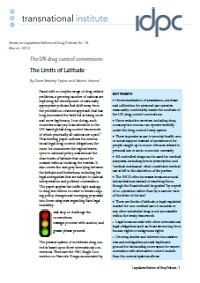The Limits of Latitude The UN drug control conventions
A growing number of nations are developing policies that shift away from the prohibition-oriented failed approach to drugs control. Ultimately however nations will need to reform the overall UN based global drug control framework of which practically all nations are a part.

Authors
This briefing paper outlines the international legal drug control obligations, the room for manoeuvre the regime leaves open to national policy makers and the clear limits of latitude that cannot be crossed without violating the treaties. It also covers the vast grey area lying between the latitude and limitations, including the legal ambiguities that are subject to judicial interpretation and political contestation.
The paper applies the traffic light analogy to drug law reform in order to divide ongoing policy changes and emerging proposals into three categories regarding their legal tenability:
 RED: stop or challenge the conventions;
RED: stop or challenge the conventions;
ORANGE: proceed with caution; and
GREEN: please proceed.
The present system of worldwide drug control is based upon three international conventions. These are the 1961 Single Convention on Narcotic Drugs, as amended by the 1972 Protocol, the 1971 Convention on Psychotropic Substances and the 1988 Convention against Illicit Traffic in Narcotic Drugs and Psychotropic Substances.
While the substance of the drug control conventions is complex, their function is simple. They provide the legal structure for an international system of drug control by defining control measures to be maintained within each state party to these conventions and by prescribing rules to be obeyed by these Parties in their relations with each other. These rules can be categorized by two principal methods of achieving drug control. These are commodity control (the definition and regulation of the licit production, supply and consumption of drugs) and penal control (the suppression through criminal law of illicit production, supply and consumption.)
The conventions therefore operate with the intention of creating an appropriate balance between penal sanctions, the degree of real and/or potential harm associated with specific drugs and their therapeutic usefulness.
The overarching concern for the ‘health and welfare of mankind’ expressed within the conventions’ preambles, required a dual goal: reducing the availability of drugs to prevent abuse and addiction that ‘constitutes a serious evil for the individual and is fraught with social and economic danger to mankind’, while at the same time ensuring adequate availability because their medical use is ‘indispensable for the relief of pain and suffering’.
The global control system, established with that twin purpose, effectively ended the large-scale diversion of narcotic drugs like cocaine and heroin from pharmaceutical sources to illicit channels. However, it was unable to prevent the resulting rapid expansion of illicit production that began supplying the non-medical market instead.
The tensions resulting from the inherent duality exacerbated as the system evolved based on the implicit principle that reducing availability for illicit purposes could only be achieved through the penal enforcement of predominantly prohibition oriented supply-side measures.
The tightening of drug laws, escalation of law enforcement efforts and an actual ‘war on drugs’ against the illicit market, over time distorted the balance at the expense of the other side of the coin.
KEY POINTS
• Decriminalization of possession, purchase and cultivation for personal use operates reasonably comfortably inside the confines of the UN drug control conventions
• Harm reduction services, including drug consumption rooms, can operate lawfully under the drug control treaty system
• There is greater scope to provide health care or social support instead of punishment for people caught up in minor offences related to personal use or socio-economic necessity
• All controlled drugs can be used for medical purposes, including heroin prescription and ‘medical marijuana’; what constitutes medical use is left to the discretion of the parties
• The INCB often increases tensions around interpretations instead of resolving them, though the Board should be guided ‘by a spirit of co-operation rather than by a narrow view of the letter of the law’
• There are limits of latitude; a legal regulated market for non-medical use of cannabis or any other scheduled drug is not permissible within the treaty framework
• Legal tensions exist with other international legal obligations such as those stemming from human rights or indigenous rights
• Growing doubts and inherent inconsistencies and ambiguities provide legitimate ground for demanding more space for experimentation with alternative control models than the current systems allows
Pages: 24

